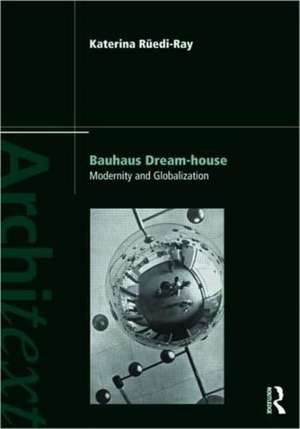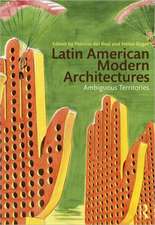Bauhaus Dream-house: Modernity and Globalization: Architext
Autor Katerina Rüedi Rayen Limba Engleză Paperback – 16 apr 2010
Developed in post WW1 Germany, the principles of Bauhaus architecture and design were transferred by some of its leading figures to architecture schools at Harvard, Chicago and the IIT. Yet in the postwar era, they also became increasingly influential in architecture schools in Western and Central Europe, Japan, South America, Africa and the Middle East. This book provides a critical examination of the profound social, cultural and spatial consequences of these developments and the erasure of class, race, gender and culture which the ‘modernisation’ of design embodied.
Written to appeal to an extensive readership, not only in the fields of architectural and design education, but in architectural history and in critical pedagogy more generally, it is also for teachers and students in German art and cultural history and the many architects worldwide who continue to be fascinated by the ideas of the Bauhaus.
| Toate formatele și edițiile | Preț | Express |
|---|---|---|
| Paperback (1) | 324.59 lei 6-8 săpt. | |
| Taylor & Francis – 16 apr 2010 | 324.59 lei 6-8 săpt. | |
| Hardback (1) | 989.55 lei 6-8 săpt. | |
| Taylor & Francis – 16 apr 2010 | 989.55 lei 6-8 săpt. |
Din seria Architext
-
 Preț: 296.00 lei
Preț: 296.00 lei -
 Preț: 303.84 lei
Preț: 303.84 lei - 16%
 Preț: 261.73 lei
Preț: 261.73 lei -
 Preț: 424.16 lei
Preț: 424.16 lei - 17%
 Preț: 233.42 lei
Preț: 233.42 lei - 18%
 Preț: 275.26 lei
Preț: 275.26 lei - 28%
 Preț: 991.00 lei
Preț: 991.00 lei - 15%
 Preț: 328.84 lei
Preț: 328.84 lei - 24%
 Preț: 360.80 lei
Preț: 360.80 lei - 24%
 Preț: 356.24 lei
Preț: 356.24 lei - 12%
 Preț: 331.51 lei
Preț: 331.51 lei - 12%
 Preț: 299.67 lei
Preț: 299.67 lei - 22%
 Preț: 373.74 lei
Preț: 373.74 lei - 19%
 Preț: 271.58 lei
Preț: 271.58 lei - 23%
 Preț: 428.28 lei
Preț: 428.28 lei - 17%
 Preț: 240.48 lei
Preț: 240.48 lei -
 Preț: 347.91 lei
Preț: 347.91 lei - 25%
 Preț: 428.37 lei
Preț: 428.37 lei - 30%
 Preț: 770.74 lei
Preț: 770.74 lei - 15%
 Preț: 458.41 lei
Preț: 458.41 lei - 16%
 Preț: 262.55 lei
Preț: 262.55 lei - 26%
 Preț: 991.00 lei
Preț: 991.00 lei - 18%
 Preț: 1071.63 lei
Preț: 1071.63 lei - 25%
 Preț: 429.08 lei
Preț: 429.08 lei - 14%
 Preț: 314.06 lei
Preț: 314.06 lei - 30%
 Preț: 769.92 lei
Preț: 769.92 lei - 24%
 Preț: 431.66 lei
Preț: 431.66 lei - 23%
 Preț: 331.19 lei
Preț: 331.19 lei -
 Preț: 450.99 lei
Preț: 450.99 lei
Preț: 324.59 lei
Preț vechi: 424.71 lei
-24% Nou
Puncte Express: 487
Preț estimativ în valută:
62.13€ • 67.51$ • 52.22£
62.13€ • 67.51$ • 52.22£
Carte tipărită la comandă
Livrare economică 21 aprilie-05 mai
Preluare comenzi: 021 569.72.76
Specificații
ISBN-13: 9780415475822
ISBN-10: 0415475821
Pagini: 240
Ilustrații: 32 halftones
Dimensiuni: 174 x 246 x 13 mm
Greutate: 0.48 kg
Ediția:1
Editura: Taylor & Francis
Colecția Routledge
Seria Architext
Locul publicării:Oxford, United Kingdom
ISBN-10: 0415475821
Pagini: 240
Ilustrații: 32 halftones
Dimensiuni: 174 x 246 x 13 mm
Greutate: 0.48 kg
Ediția:1
Editura: Taylor & Francis
Colecția Routledge
Seria Architext
Locul publicării:Oxford, United Kingdom
Public țintă
PostgraduateCuprins
Introduction. Prologue 1. Tracing-house 2. Dream-house Part 1: Weimar Republic, 1919-1933 3. Charnel-house 4. Ware-house Part 2: Europe and Beyond, 1919 – 1968 5. Club-house 6. School-house. Conclusion: House-of-the-Father
Notă biografică
Katerina Rüedi Ray is Professor and Director Emerita of the School of Art at Bowling Green State University. Former Director of the School of Architecture at the University of Illinois at Chicago, she studied at the Architectural Association and University College London and has taught, published and exhibited extensively in Europe and the USA.
Recenzii
'At the same time as filling out the general knowledge gleaned from the corpus of texts on the Bauhaus that preceded it Bauhaus Dream-House is a dramatic reminder that the fourteen year troubled existence of this school generated ideas that were powerful enough to maintain their relevance on a global stage' – International Journal of Education through Art
'...this book can appeal to an extensive readership not only in the field of visual arts education but also in history, pedagogy and even business. Anyone who is curious about the phenomenon of the Bauhaus will also find this book fascinating.'– Leonardo
'Engaging and erudite' – Planning Perspectives
'Bauhaus Dream-House effectively challenges the reader to re-examine not only the conventional narratives of the Bauhaus and its role in the development of modernism, but also its out-sized influence as a pedagogical model...Indeed, this book is particularly valuable for those teaching in schools of art, architecture, and design, as many of these institutions still aim to replicate, to varying degrees, the Bauhaus system.' – Design Issues
‘The book is thoroughly researched, sometimes provocative and often fascinating, and its strength lies in Ruedi Ray’s identification of this misappropriation worldwide, in locations as far-flung as Turkey and Brazil. The sections on the USSR and the 1938 MOMA exhibition are outstanding. Her research into the Bauhaus firm, the GmbH, is a fresh insight into the financial workings of the institution and the pressure it was under.’ – Melissa Trimingham, Journal of Theatre Research Review, University of Kent, UK
"The strength of this book is its radical departure from the assumptions that have governed most earlier literature on this subject... Ray's book offers compelling evidence of a welcome shift in the writing of history of the Bauhaus, and indeed of modern architecture and design in general."- Kathleen James-Chakraborty, The Society of Architectural Historians
"... Ruedi Ray contributes to the existing scholarship on the Bauhaus's pedagogy by engaging with theory and using unconventional tools to provide new interpretations of some of its aspects that would have remained hidden if analysed only through the traditional instruments of historical research." - Daniela N. Prina, Journal of Design History, Vol. 25, No. 2
'At the same time as filling out the general knowledge gleaned from the corpus of texts on the Bauhaus that preceded it Bauhaus Dream-House is a dramatic reminder that the fourteen year troubled existence of this school genereated ideas that were powerful enough to maintain their relevance on a global stage' – International Journal of Education through Art
'...this book can appeal to an extensive readership not only in the field of visual arts education but also in history, pedagogy and even business. Anyone who is curious about the phenomenon of the Bauhaus will also find this book fascinating.'– Leonardo
'Engaging and erudite' – Planning Perspectives
'Bauhaus Dream-House effectively challenges the reader to re-examine not only the conventional narratives of the Bauhaus and its role in the development of modernism, but also its out-sized influence as a pedagogical model...Indeed, this book is particularly valuable for those teaching in schools of art, architecture, and design, as many of these institutions still aim to replicate, to varying degrees, the Bauhaus system.' – Design Issues
‘The book is thoroughly researched, sometimes provocative and often fascinating, and its strength lies in Ruedi Ray’s identification of this misappropriation worldwide, in locations as far-flung as Turkey and Brazil. The sections on the USSR and the 1938 MOMA exhibition are outstanding. Her research into the Bauhaus firm, the GmbH, is a fresh insight into the financial workings of the institution and the pressure it was under.’ – Melissa Trimingham, Journal of Theatre Research Review, University of Kent, UK
"The strength of this book is its radical departure from the assumptions that have governed most earlier literature on this subject... Ray's book offers compelling evidence of a welcome shift in the writing of history of the Bauhaus, and indeed of modern architecture and design in general."- Kathleen James-Chakraborty, The Society of Architectural Historians
"... Ruedi Ray contributes to the existing scholarship on the Bauhaus's pedagogy by engaging with theory and using unconventional tools to provide new interpretations of some of its aspects that would have remained hidden if analysed only through the traditional instruments of historical research." - Daniela N. Prina, Journal of Design History, Vol. 25, No. 2
'At the same time as filling out the general knowledge gleaned from the corpus of texts on the Bauhaus that preceded it Bauhaus Dream-House is a dramatic reminder that the fourteen year troubled existence of this school genereated ideas that were powerful enough to maintain their relevance on a global stage' – International Journal of Education through Art
Descriere
This original study brings critical social theory to bear on the ideas of architectural and design education at the Bauhaus – tracing the spread and influence of these ideas worldwide.
Written for those in the fields of architectural and design education, architectural history and critical pedagogy, it is also for teachers and students in German art and cultural history.
Written for those in the fields of architectural and design education, architectural history and critical pedagogy, it is also for teachers and students in German art and cultural history.












